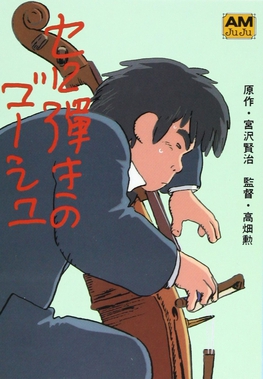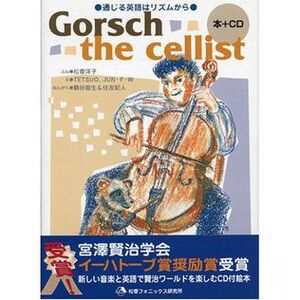Gauche the Cellist facts for kids

1982 Japanese edition, with artwork from the 1982 film
|
|
| Author | Kenji Miyazawa |
|---|---|
| Original title | セロ弾きのゴーシュ Sero Hiki no Gōshu |
| Translator | John Bester |
| Country | Japan |
| Language | Japanese |
| Genre | Fantastic, Juvenile, Philosophical, Parable |
|
Publication date
|
1934 |
|
Published in English
|
1994 |
| Media type | Novel |
Gauche the Cellist (セロ弾きのゴーシュ, Sero Hiki no Gōshu, also transliterated Gorsch the Cellist or Goshu the Cellist) is a famous short story by the Japanese writer Kenji Miyazawa. It's about a young man named Gauche who plays the cello. He lives in a small town and isn't very good at music at first. But then, he meets some talking animals who help him understand music better.
This story has been translated into many languages, like English, Italian, and Spanish. It was also made into a popular anime movie in 1982 by Isao Takahata. Before that, it was adapted for the screen several times.
Contents
The Story of Gauche and His Cello
Gauche is a hard-working but average cellist in a small town. He plays for an orchestra called The Venus Orchestra (金星音楽団, Kinsei Ongaku Dan). He also plays music for the local movie theater.
Gauche often struggles during music rehearsals. His conductor (the person who leads the orchestra) often gets upset with him. They are getting ready for a big concert where they will play Beethoven's Sixth Symphony, also known as the Pastoral Symphony.
Gauche's Animal Visitors
Over four nights, strange things happen at Gauche's home, which is a mill house. Talking animals visit him while he practices his cello.
- Night One: The Cat
The first night, a tortoiseshell cat comes to Gauche's house. The cat brings him a tomato from his garden and asks him to play "Träumerei" by Robert Schumann. Gauche gets annoyed because the tomato is from his own garden! Instead, he plays a loud song called "Tiger Hunt in India." This scares the cat, and it jumps around in surprise before running away.
- Night Two: The Cuckoo
On the second night, a cuckoo bird visits. It asks Gauche to practice scales with his cello. Gauche plays "cuckoo, cuckoo" over and over, and the bird sings along. Gauche starts to feel that the cuckoo's song is better than his cello playing. He chases the bird away, and it flies into his window, bumping its head.
- Night Three: The Raccoon Dog
The third night, a Japanese raccoon dog (called a tanuki) comes to practice the timpani (a type of drum) with Gauche's cello. Gauche plays a song called "The Merry Master of a Coach Station." The tanuki hits the cello with a drum stick to practice. The tanuki tells Gauche that he plays slowly, even when he tries to play fast. They end up on good terms as the sun rises.
- Night Four: The Mice
On the fourth night, a mother mouse arrives with her baby. She asks Gauche to heal her sick son. Gauche says he's not a doctor, but the mother mouse explains that his music has already healed other animals. Gauche gently puts the tiny sick mouse into a hole in his cello. He then plays a beautiful rhapsody. When he finishes, the little mouse is completely fine and starts running around! The mother mouse cries and thanks Gauche before leaving.
The Big Concert
The concert, where Gauche plays the Sixth Symphony, is a huge success! In the dressing room after the show, the conductor asks Gauche to play an extra song, called an encore. Gauche is surprised. When he hears the audience cheering, he thinks they are making fun of him. So, he plays "Tiger Hunt in India" again. Afterwards, everyone in the dressing room congratulates him on his amazing performance.
When Gauche returns home, he opens the window where the cuckoo had hit its head. He feels sorry for how he acted. The story ends with Gauche and the animals living peacefully, enjoying the music of the Pastoral Symphony.
Movie and TV Versions
The story of Gauche the Cellist has been made into movies and TV shows several times.
The 1982 Anime Film
In 1982, a Japanese animation studio called Oh! Production turned the story into an animated movie. It was directed and written by Isao Takahata. He later helped start Studio Ghibli with Hayao Miyazaki, who made famous movies like My Neighbor Totoro.
The person who did Gauche's voice acting was Hideki Sasaki. The lead animator, Shunji Saida, even took cello lessons! He wanted to make sure the finger movements in the film looked exactly right. This 63-minute movie took six years to make. It was highly praised as one of the best movie versions of Kenji Miyazawa's stories.
The film was released on DVD in Japan in 2000 with English subtitles. Later, in 2006, Studio Ghibli and Buena Vista Home Entertainment re-released it. This was to celebrate 110 years since Kenji Miyazawa was born.
Earlier Adaptations
Before the 1982 anime, the story was made into films three other times: in 1949, 1953, and 1963.
- The 1949 version was an animated film directed by Yoshitsugu Tanaka.
- The 1953 version used puppets and dolls and was directed by Kenjiro Morinaja.
- The 1963 version was also animated and directed by Matsue Jinbo.
Translations of the Story
Gauche the Cellist has been translated into English by different people.
John Bester translated it along with other short stories in a book called Once and Forever, the Tales of Kenji Miyazawa. This book was published in 1994. Another person, Roger Pulvers, also translated the story into English.
Youko Matsuka translated the story into a simpler English version. She published it in Japan under the title "Gorsch the Cellist".
The story has also been translated into Italian by Muramatsu Mariko. It was part of a collection called Il violoncellista Goshu e altri scritti, published in 1987.
More to Explore
- Once and Forever, the Tales of Kenji Miyazawa on Amazon.com
- Isao Takahata's 1982 animation of Gauche the Cellist on IMDB
- JMDB page on Isao Takahata's 1982 animation of Gauche the Cellist
- Yoshitsugu Tanaka's 1949 animation of Gauche the Cellist on IMDB
- JMDB page on Yoshitsugu Tanaka's 1949 animation of Gauche the Cellist
- Kenjiro Morinaga's 1953 puppet adaptation of Gauche the Cellist on IMDB
- JMDB page on Matsue Jinbo's 1963 animation of Gauche the Cellist


